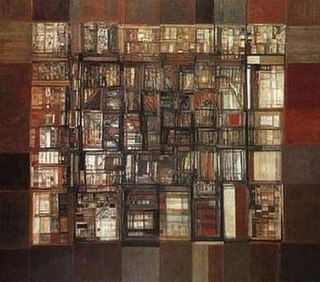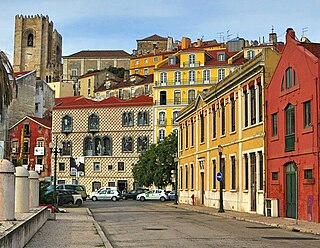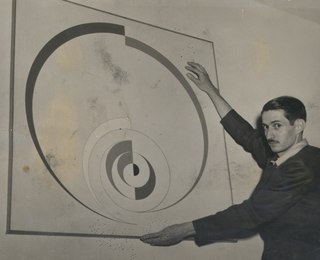
The Calouste Gulbenkian Museum houses one of the world's most important private art collections. It includes works from Ancient Egypt to the early 20th century, spanning the arts of the Islamic World, China and Japan, as well as the French decorative arts, the jewellery of René Lalique and some of the most important painters of all times works such as Rembrandt, Monet, Rubens, Manet, Renoir, Degas and Turner.

Maria Helena Vieira da Silva was a Portuguese abstract painter. She was considered a leading member of the European abstract expressionism movement known as Art Informel. Her works feature complex interiors and city views using lines that explore space and perspective. She also worked in tapestry and stained glass.

João Cutileiro OSE was a Portuguese sculptor. He is responsible for a number of controversial female nudes in marble.
The Calouste Gulbenkian Foundation, commonly referred to simply as the Gulbenkian Foundation, is a Portuguese institution dedicated to the promotion of the arts, philanthropy, science, and education. One of the wealthiest charitable foundations in the world, the Gulbenkian Foundation was founded on 18 July 1956 according to the last will and testament of Calouste Sarkis Gulbenkian, a Portugal-based oil magnate who bequeathed his assets to the country in the form of a foundation.
António Dacosta was a Portuguese painter, poet and art critic and a pioneer of the surrealist movement in Portugal.
Marcelino Macedo Vespeira was a Portuguese painter and graphic artist. A leading figure in the surrealist movement in Portugal, Vespeira built a long and diversified work. It emerged in the mid-1940s in the context of Portuguese neo-realism, it reached a high point in the surrealist and intensely personal works made between 1948 and 1952; after that he went through abstractionism to return, in more recent decades, to the themes and forms from his surrealist period.

Hélio Oiticica was a Brazilian visual artist, sculptor, painter, performance artist, and theorist best known for his participation in the Neo-Concrete Movement, for his innovative use of color, and for what he later termed "environmental art," which included Parangolés and Penetrables, like the famous Tropicália. Oiticica was also a filmmaker and writer.
António Palolo was a Portuguese artist and painter.
Ana Vieira was a Portuguese artist.
Alberto Carneiro was a Portuguese artist.

A Library Burning is an oil on canvas painting by the Portuguese artist Maria Helena Vieira da Silva, created in 1974. It is held at the Centro de Arte Moderna Gulbenkian, in Lisbon.

Greyhounds is a painting by Amadeo de Souza Cardoso, from 1911.

Lisbon is one of the most popular city destinations in Europe. The city of Lisbon and the Lisbon metropolitan area attracts a significant number of tourists each year, drawn to its historical and cultural heritage, good transportation connections and good touristic infrastructure.
Born in South Africa, Michael Edward Bolus was an artist and teacher who settled in England in 1957 and studied at St Martin's School of Art from 1958 to 1962, studying under Anthony Caro. After a brief period living in Cape Town he returned to London in 1964 to begin a teaching post at St Martin's and the Central School of Art and Design. Bolus had his first UK solo exhibition at Waddington Galleries in 1968, which has exhibited a number of his sculptures since then.

Ivan Ferreira Serpa was a Brazilian painter, draftsman, printmaker, designer, and educator active in the concrete art movement. Much of his work was in geometric abstractionism. He founded Grupo Frente, which included fellow artists Lygia Clark, Helio Oiticica, and Franz Weissmann, among others, and was known for mentoring many artists in Brazil.

Mónica de Miranda is a Portuguese visual artist, photographer, filmmaker, and researcher of Angolan ancestry known for her artwork on socially inspired themes, including postcolonial issues of geography, history, and subjectivity related to Africa and its diaspora. Her media include photography, mixed media and video. De Miranda first became known for her photographic records of the ruins of modern hotels in post-war Angola, and their surrounding sociopolitical circumstances. Her photographic series, videos, short films, and installations have been internationally exhibited at art biennales, galleries, and museums, some of which keep her work in their permanent art collections. Her work has been reviewed in specialized art sources.

José Pedro Croft is a visual artist. Considered as one of the main representatives of the revival of Portuguese sculpture, he is widely known for his geometric sculptures and paintings.
Ana Vidigal is a Portuguese artist whose work mainly involves the use of collages.

Fernanda Fragateiro is a Portuguese artist and sculptor who mainly collaborates with architects and landscape architects.













